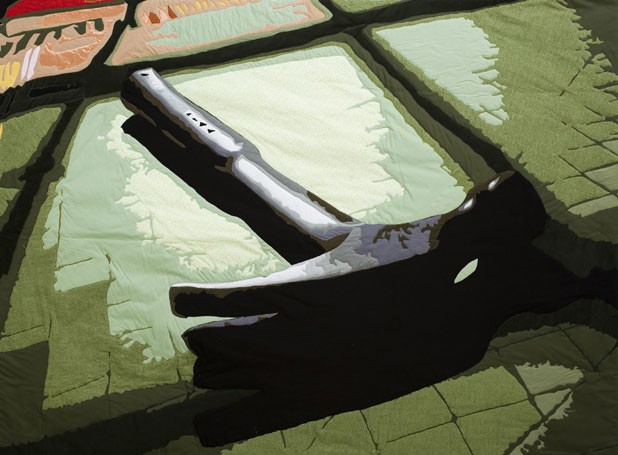
In its exhibit “Man-Made Quilts: Civil War to the Present,” the Shelburne Museum presents some gorgeous textile creations, most accompanied by great stories. But one thing might irk some female viewers: The show celebrates men picking up a women-dominated craft and doing it with at least as much, if not more, creativity than their female counterparts.
The exhibit certainly doesn’t set out to make women quilters seem boring. Instead, it explores the “outsider” quality of quilts made by men. “Men took up quilting because they were wounded in a war and needed a recuperative activity,” explains senior curator Jean Burks, who began exploring the role men have played in quilt making for this exhibit about two years ago. Men also turned to quilting to commemorate events. But, just as often, men simply wanted to compete.
“Men appear to come up with an idea or inspiration and then study the techniques to execute it,” a placard in the exhibit reads. This subject-first approach differs from that of women, “who historically master the requisite sewing, piecing and quilting skills and then select a known pattern to demonstrate their proficiency.”
The roughly 20 quilts in the Hat and Fragrance Textile Gallery through October are on loan from other museums and private collections, with the exception of a quilt made by a Union soldier during the Civil War, which is part of the Shelburne Museum’s permanent collection and inspired the exhibit.
While recovering from wounds sustained in battle, the discharged soldier — whose identity is unknown — poured hours into this striking quilt. Repetitive, meditative handiwork was seen as therapeutic, but, as a description notes, this soldier “did not quite get away from it all.” Images of armed soldiers and horses march steadily across his quilt.
In a room filled with contemporary quilts, San Francisco architect-turned-quilter Luke Haynes’ “Man Stuff #1” is a standout. He presents an oversize realist depiction of his favorite hammer lying diagonally on an olive-green and orange quilt, riffing on the perspective and movement in Gustave Caillebotte’s “The Floor Scrapers.”
In a decidedly male display of technical bells and whistles, a circular quilt depicting the universe’s planets and stars is motorized, keeping it constantly spinning and humming on the wall. Near it hangs a defiant half-white, half-quilted piece by Jeffrey Gutcheon. Burks says when Gutcheon first showed it, people reacted with “When are you going to finish it?”
In the gallery’s next room, quilts trick the eye and baffle the mind. Pennsylvania quilter George Siciliano uses thousands of teeny-tiny pieces of fabric to create intricate wall hangings. He would go smaller, a placard explains, if only he could find smaller needles.
Fraser Smith’s “Calypso” appears to be a brightly colored quilt, folded a few times and draped over a clothesline. But, on closer examination, the piece is revealed to be a convincing, painted-wood trompe l’oeil. For proof, dumbfounded viewers can touch a sample version of Smith’s work also mounted on the wall.
The contemporary quilts are beautiful and surprising, but the background stories are even better in the next room, which is filled with quilts from another era.
The description of an 1884 “Postage Stamp” quilt top made from 2500 1-and-a-half-inch squares reads like the intriguing first line of a thriller: “Seventeen-year-old Dwight Bradley made his quilt top while recovering from an accident with an ax.”
Sentimental gallerygoers may get teary-eyed reading about Carl Klewicke’s “Wedding Quilt” from 1904, made from gorgeous, curving strips of silk, satin and taffeta. Klewicke, who immigrated to the United States from Germany in 1867, was a skilled tailor with no children — until a 3-month-old baby girl appeared on his and his wife’s doorstep. He made the quilt, vibrant with triumphant imagery such as a dove with wings outstretched, from scraps left over from his tailoring business and gave it to his adopted daughter on her wedding day.
Other quilts offer mysteries. Benjamin Franklin Perkins, a street paver and bricklayer in Portland, Maine, made one in the 1840s out of simple rectangular patches. “It’s no coincidence that the color scheme and organization of the individual red and white cloth pieces represent the size and shape of Portland sidewalk bricks laid out in a traditional herringbone paving pattern,” reads the description. But why did he turn to quilting, and how did he learn?
Albert Small turned to quilting on a dare. In 1940s Illinois, after he teased his wife and her quilting group about a piece they’d worked on for weeks, the women challenged him to make his own. He made three, one of which broke a quilting record for most pieces in the world, with 123,000 tiny hexagonal pieces.
The quilt, “Hexagon Mosaic #3,” is mesmerizing, with yellow, pink and blue stars seemingly bursting from the fabric. For a certain kind of competitive female viewer, it’s enough to inspire her to dust off the old sewing machine and try for something bigger.
“Man-Made Quilts: Civil War to the Present,” quilts made by men, Shelburne Museum. Through October 28. Info, 985-3346. shelburnemuseum.org









Comments
Comments are closed.
From 2014-2020, Seven Days allowed readers to comment on all stories posted on our website. While we've appreciated the suggestions and insights, right now Seven Days is prioritizing our core mission — producing high-quality, responsible local journalism — over moderating online debates between readers.
To criticize, correct or praise our reporting, please send us a letter to the editor or send us a tip. We’ll check it out and report the results.
Online comments may return when we have better tech tools for managing them. Thanks for reading.